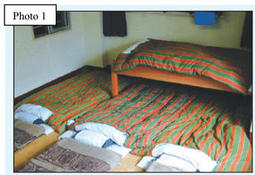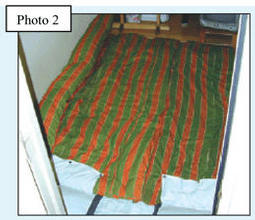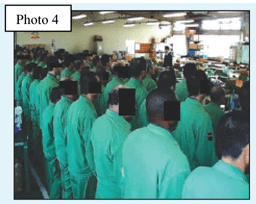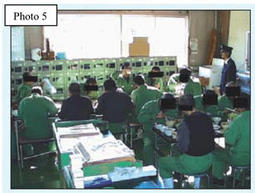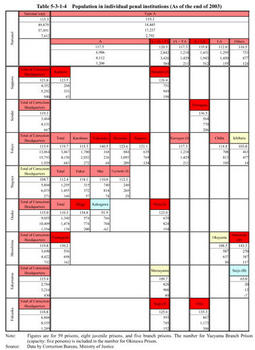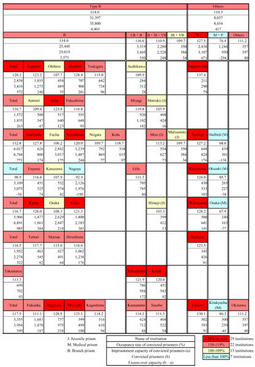| Previous Next Index Image Index Year Selection | |
|
|
2. Measures for prison overcrowding In order to fundamentally resolve the overcrowding,it is necessary to improve facilities and also increase prison staff.Since constructing new facilities would require larger cost and longer time,the following measures are being taken for the time being.
(1) Measures to improve facilities a. Securingcells The first problem that arises from the increase in inmate population is how to secure cells.To accommodate more persons than capacity,many prisons provide group cells with double bunk beds to increase the amount of available space within cells and accommodate one or two extra inmates in addition to the normal imprisonment capacity(six persons).If no alternative is available,two inmates are placed in a solitary cell designed for one.Furthermore,many prisons convert or remodel warehouses,classrooms or assembly halls to utilize them as cells.
As of May31,2004,48of63prisons(55prisons and8juvenile prisons,not including medical prisons)provided group cells with double bunk beds and23prisons provided solitary cells with double bunk beds(Source:Data by Correction Bureau,Ministry of Justice). In the past three years,45prisons conducted remodeling to increase imprisonment capacity for convicted prisoners in2001(capacity up by1,377persons),no prison in2002and23prisons in2003(capacity up by323persons)(not including medical prisons;Source:Data by Correction Bureau,Ministry of Justice). Prison overcrowding Photo1 Photo2 Photo3 Photo4 Photo5 Photo1: Extra bed placed in a group cell to increase capacity(this situation is also referred in the text as providing a"double bunk bed").Photo2: Bedclothes for two persons provided in a solitary cell to accommodate two persons in a cell designed for one. Photo3: Some prisons place double bunk beds in library to use it temporarily as a cell. Photo4: Prisoners form lines before going to work at the factory. Photo5: Some prisoners have meals in working areas of factories because the number of prison workers exceeds the factory's dining room capacity. b. Securing space for works and dining in factories Overcrowding does not only influence cell management.The majority of convicted prisoners are sentenced to imprisonment with labor and thus required to engage in prison work.However,prisons are running short of space in factories to match increased numbers of prison workers.In response,various measures are being taken to increase working space,such as remodeling classrooms into workplaces,integrating adjoining warehouses with factories or using a part of prison hallways as working spaces.Furthermore,prisoners engaging in prison work are to have meals in the factory dining room.However,many prison factories those lack space in dining room capacity due to overpopulation have installed tables and chairs in hallways and working places to use them as dining space or refurnished those rooms originally intended for other purposes.
Fig. 5-3-1-3Population in individual penal institutions(As of the end of2003) Table 5-3-1-4Population in individual penal institutions(As of the end of2003) (2) Measures to improve operationetc. In addition to the measures mentioned above to improve tangible aspects such as prison facilities,each institution has various considerations for improving the intangible aspects such as operation of the institution.
In order to soothe inmates who are apt to suffer from stress in overcrowded environments,there are attempts to improve appearance of facilities by repainting cell walls and creating flowerbeds for inmates to take care.Prisons are also organizing various events to alleviate stress among inmates such as athletic meetings more frequently.However,since overcrowding makes it difficult for some institutions to have all inmates participate in a particular event at once,they hold the same event more than once. Furthermore,because overcrowding caused all simple daily activities,such as moving inmates from one place to another to allow them to wash their faces,take a bath,etc.,to be more time consuming.Therefore,some institutions adopted more flexible activity schedules.In other institutions,cells are changed every three months to reduce conflicts among inmates by preventing co-inmates from being fixed for long time. |
